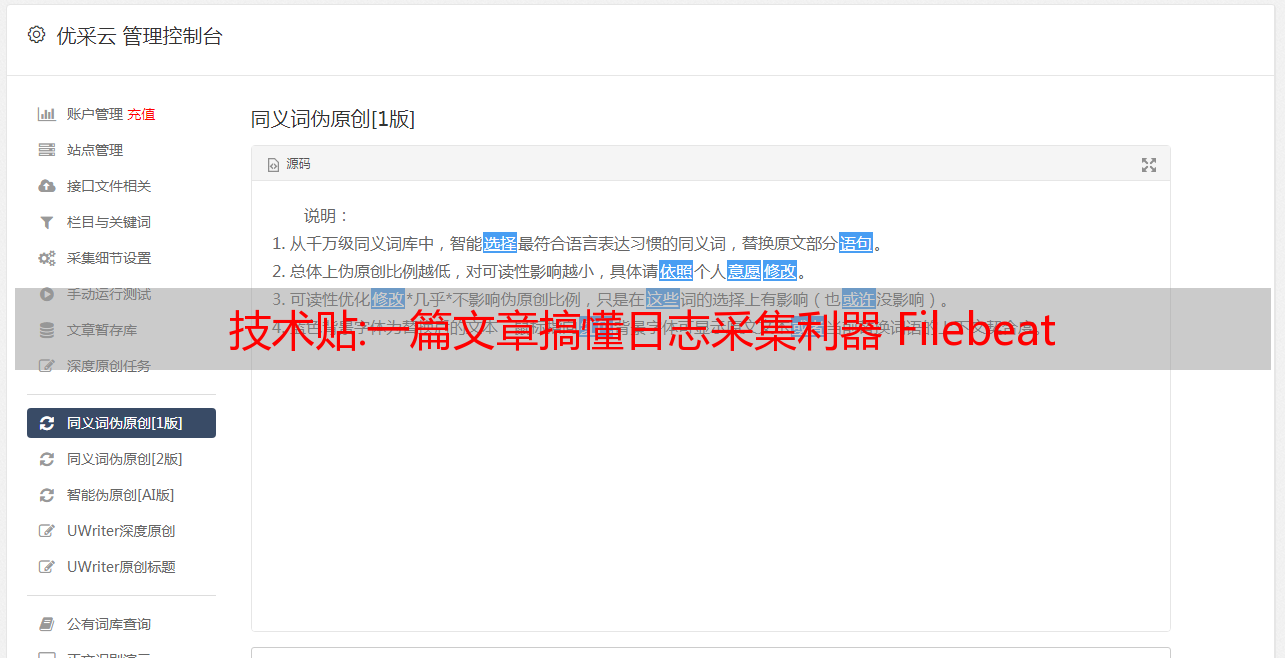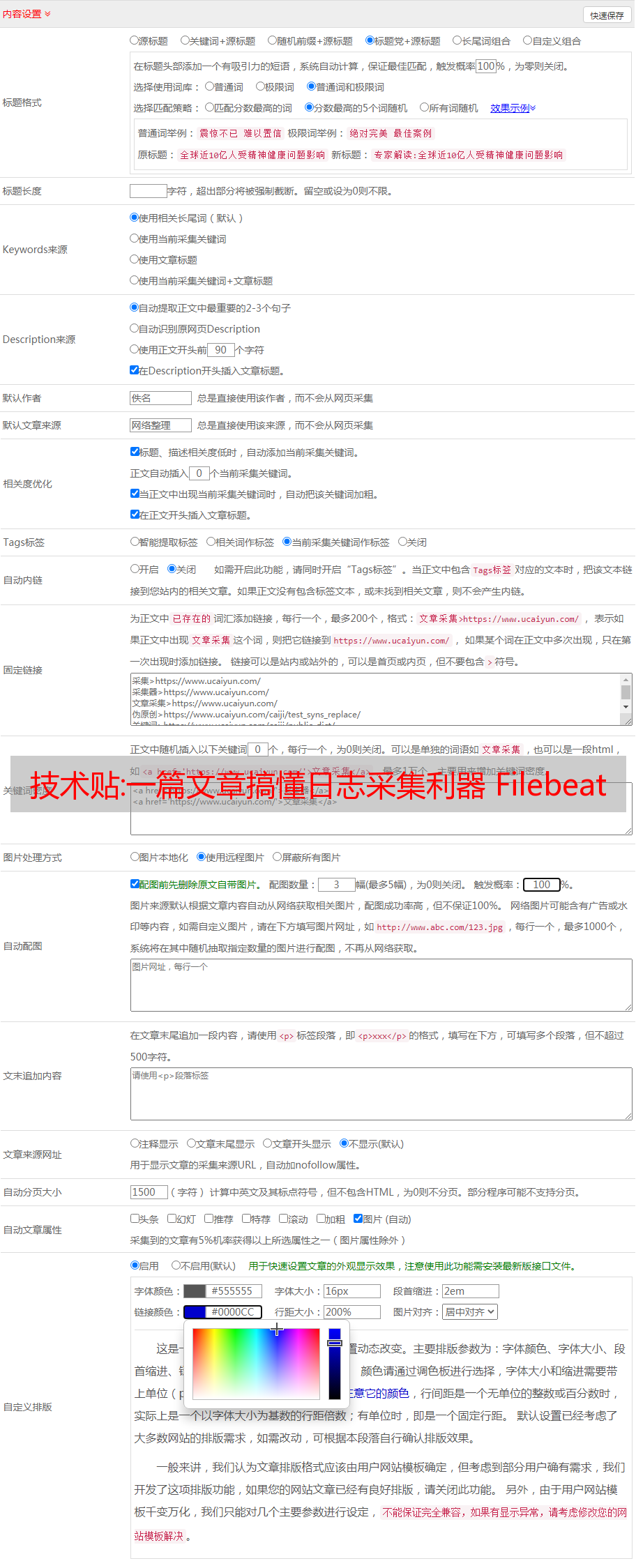技术贴:一篇文章搞懂日志采集利器 Filebeat
优采云 发布时间: 2022-10-22 06:34技术贴:一篇文章搞懂日志采集利器 Filebeat
原文链接:
本文使用的 Filebeat 是 7.7.0 版本。文章 将解释以下几个方面:
什么是 Filebeat
Filebeat和Beats的关系
首先,Filebeat 是 Beats 的一员。
Beats 是一个轻量级的日志采集器。事实上,Beats 家族有 6 个成员。在早期的 ELK 架构中,Logstash 被用来采集和解析日志,但是 Logstash 会消耗更多的内存、CPU、io 等资源。与 Logstash 相比,Beats 占用的系统 CPU 和内存几乎可以忽略不计。
Beats 目前包括六种工具:
什么是 Filebeat
Filebeat 是一个用于转发和集中日志数据的轻量级交付工具。Filebeat 监控您指定的日志文件或位置,采集日志事件,并将它们转发到 Elasticsearch 或 Logstash 进行索引。
Filebeat 的工作原理是这样的:当您启动 Filebeat 时,它会启动一个或多个输入,并在为日志数据指定的位置中查找这些输入。对于 Filebeat 找到的每个日志,Filebeat 都会启动一个采集器。每个采集器读取单个日志以获取新内容并将新日志数据发送到 libbeat,libbeat 将聚合事件并将聚合数据发送到为 Filebeat 配置的输出。
工作流程图如下:
Filebeat和Logstash的关系
由于Logstash是JVM运行的,资源消耗比较大,所以作者后来在Golang中写了一个功能少但资源消耗少的轻量级logstash-forwarder。然而,作者只是一个人。加入公司后,ES公司本身也收购了另一个开源项目Packetbeat,而且这个项目独家使用Golang,拥有一个完整的团队,所以ES公司干脆将logstash-forwarder的开发工作合并到同一个Golang团队来工作,所以新项目名为 Filebeat。
Filebeat的原理是什么
Filebeat的组成
Filebeat 结构:由两个组件组成,inputs(输入)和harvesters(采集器),它们共同工作以跟踪文件并将事件数据发送到您指定的输出。收割机负责读取单个文件的内容。收割机逐行读取每个文件并将内容发送到输出。为每个文件启动一个收割机。收割机负责打开和关闭文件,这意味着文件描述符在收割机运行时保持打开状态。如果文件在采集过程中被删除或重命名,Filebeat 将继续读取该文件。这样做的一个副作用是磁盘上的空间被保留,直到收割机关闭。默认情况下,Filebeat 会保持文件打开,直到达到 close_inactive。
关闭收割机可以产生结果:
输入负责管理收割机并查找所有要读取的资源。如果输入类型是日志,输入将查找驱动器上与定义的路径匹配的所有文件,并为每个文件启动收割机。每个输入都运行在自己的 Go 进程中,Filebeat 目前支持多种输入类型。每种输入类型都可以定义多次。日志输入检查每个文件以查看是否需要启动收割机,收割机是否已在运行,或者是否可以忽略该文件。
Filebeat 如何保存文件的状态
Filebeat 会保存每个文件的状态,并经常将状态刷新到磁盘上的注册表文件中。此状态用于记住收割机读取的最后一个偏移量,并确保发送所有日志行。如果输出不可访问(如 Elasticsearch 或 Logstash),Filebeat 将跟踪发送的最后一行,并在输出再次可用时继续读取文件。当 Filebeat 运行时,每个输入的状态信息也保存在内存中。当 Filebeat 重新启动时,来自注册表文件的数据用于重建状态,并且 Filebeat 在最后一个已知位置继续每个收割机。对于每个输入,Filebeat 都会保留它找到的每个文件的状态。由于文件可以重命名或移动,因此文件名和路径不足以识别文件。对于每个文件,
Filebeat 如何保证至少一次数据消耗
Filebeat 保证事件将至少传递到配置的输出一次,并且不会丢失任何数据。因为它将每个事件的传递状态存储在注册表文件中。在定义的输出被阻塞并且所有事件都未被确认的情况下,Filebeat 将继续尝试发送事件,直到输出确认已接收到事件。如果 Filebeat 在发送事件的过程中关闭,它不会在关闭之前等待输出确认所有事件。当 Filebeat 重新启动时,在 Filebeat 关闭之前未确认的所有事件都会再次发送到输出。这可确保每个事件至少发送一次,但您最终可能会将重复的事件发送到输出。
如何播放 Filebeat
压缩包安装
本文使用压缩包安装,Linux版本,filebeat-7.7.0-linux-x86_64.tar.gz。
<p style="font-size: 12px;font-family: 'Operator Mono', Consolas, Monaco, Menlo, monospace;display: -webkit-box;overflow-x: auto;padding: 16px;color: rgb(171, 178, 191);background: rgb(40, 44, 52);border-radius: 0px;margin-left: 8px;margin-right: 8px;">curl-L-Ohttps://artifacts.elastic.co/downloads/beats/filebeat/filebeat-7.7.0-linux-x86_64.tar.gz<br />tar -xzvf filebeat-7.7.0-linux-x86_64.tar.gz</p>
配置示例文件:filebeat.reference.yml(包括所有非过时的配置项)
配置文件:filebeat.yml
基本命令
详情见官网:
<p style="font-size: 12px;font-family: 'Operator Mono', Consolas, Monaco, Menlo, monospace;display: -webkit-box;overflow-x: auto;padding: 16px;color: rgb(171, 178, 191);background: rgb(40, 44, 52);border-radius: 0px;margin-left: 8px;margin-right: 8px;">export #导出<br />run #执行(默认执行)<br />test #测试配置<br />keystore #秘钥存储<br />modules #模块配置管理<br />setup #设置初始环境</p>
例如:./filebeat test config #用于测试配置文件是否正确
输入输出
支持的输入组件:
Multilinemessages、Azureeventhub、CloudFoundry、Container、Docker、GooglePub/Sub、HTTPJSON、Kafka、Log、MQTT、NetFlow、Office 365 Management Activity API、Redis、s3、Stdin、Syslog、TCP、UDP(最常用的是Log)
支持的输出组件:
Elasticsearch、Logstash、Kafka、Redis、File、Console、ElasticCloud、Changetheoutputcodec(最常用的是Elasticsearch、Logstash)
密钥库的使用
keystore主要是防止敏感信息泄露,比如密码等,像ES的密码,这里可以生成一个与ES_PWD的key,一个ES的密码的对应关系,使用的时候可以使用${ES_PWD} ES使用的密码。
例如:后面可以通过${ES_PWD}来使用它的值,例如:
<p style="font-size: 12px;font-family: 'Operator Mono', Consolas, Monaco, Menlo, monospace;display: -webkit-box;overflow-x: auto;padding: 16px;color: rgb(171, 178, 191);background: rgb(40, 44, 52);border-radius: 0px;margin-left: 8px;margin-right: 8px;">output.elasticsearch.password:"${ES_PWD}"</p>
filebeat.yml 配置(以日志输入类型为例)
详情见官网:
type: log #input类型为log<br />enable: true #表示是该log类型配置生效<br />paths: #指定要监控的日志,目前按照Go语言的glob函数处理。没有对配置目录做递归处理,比如配置的如果是:<br />- /var/log/* /*.log #则只会去/var/log目录的所有子目录中寻找以".log"结尾的文件,而不会寻找/var/log目录下以".log"结尾的文件。<br />recursive_glob.enabled: #启用全局递归模式,例如/foo/**包括/foo, /foo/*, /foo/*/*<br />encoding:#指定被监控的文件的编码类型,使用plain和utf-8都是可以处理中文日志的<br />exclude_lines: ['^DBG'] #不包含匹配正则的行<br />include_lines: ['^ERR', '^WARN'] #包含匹配正则的行<br />harvester_buffer_size: 16384 #每个harvester在获取文件时使用的缓冲区的字节大小<br />max_bytes: 10485760 #单个日志消息可以拥有的最大字节数。max_bytes之后的所有字节都被丢弃而不发送。默认值为10MB (10485760)<br />exclude_files: ['\.gz$'] #用于匹配希望Filebeat忽略的文件的正则表达式列表<br />ingore_older: 0 #默认为0,表示禁用,可以配置2h,2m等,注意ignore_older必须大于close_inactive的值.表示忽略超过设置值未更新的<br />文件或者文件从来没有被harvester收集<br />close_* #close_ *配置选项用于在特定标准或时间之后关闭harvester。 关闭harvester意味着关闭文件处理程序。 如果在harvester关闭<br />后文件被更新,则在scan_frequency过后,文件将被重新拾取。 但是,如果在harvester关闭时移动或删除文件,Filebeat将无法再次接收文件<br />,并且harvester未读取的任何数据都将丢失。<br />close_inactive #启动选项时,如果在制定时间没有被读取,将关闭文件句柄<br />读取的最后一条日志定义为下一次读取的起始点,而不是基于文件的修改时间<br />如果关闭的文件发生变化,一个新的harverster将在scan_frequency运行后被启动<br />建议至少设置一个大于读取日志频率的值,配置多个prospector来实现针对不同更新速度的日志文件<br />使用内部时间戳机制,来反映记录日志的读取,每次读取到最后一行日志时开始倒计时使用2h 5m 来表示<br />close_rename #当选项启动,如果文件被重命名和移动,filebeat关闭文件的处理读取<br />close_removed #当选项启动,文件被删除时,filebeat关闭文件的处理读取这个选项启动后,必须启动clean_removed<br />close_eof #适合只写一次日志的文件,然后filebeat关闭文件的处理读取<br />close_timeout #当选项启动时,filebeat会给每个harvester设置预定义时间,不管这个文件是否被读取,达到设定时间后,将被关闭<br />close_timeout 不能等于ignore_older,会导致文件更新时,不会被读取如果output一直没有输出日志事件,这个timeout是不会被启动的,<br />至少要要有一个事件发送,然后haverter将被关闭<br />设置0 表示不启动<br />clean_inactived #从注册表文件中删除先前收获的文件的状态<br />设置必须大于ignore_older+scan_frequency,以确保在文件仍在收集时没有删除任何状态<br />配置选项有助于减小注册表文件的大小,特别是如果每天都生成大量的新文件<br />此配置选项也可用于防止在Linux上重用inode的Filebeat问题<br />clean_removed #启动选项后,如果文件在磁盘上找不到,将从注册表中清除filebeat<br />如果关闭close removed 必须关闭clean removed<br />scan_frequency #prospector检查指定用于收获的路径中的新文件的频率,默认10s<br />tail_files:#如果设置为true,Filebeat从文件尾开始监控文件新增内容,把新增的每一行文件作为一个事件依次发送,<br />而不是从文件开始处重新发送所有内容。<br />symlinks:#符号链接选项允许Filebeat除常规文件外,可以收集符号链接。收集符号链接时,即使报告了符号链接的路径,<br />Filebeat也会打开并读取原始文件。<br />backoff: #backoff选项指定Filebeat如何积极地抓取新文件进行更新。默认1s,backoff选项定义Filebeat在达到EOF之后<br />再次检查文件之间等待的时间。<br />max_backoff: #在达到EOF之后再次检查文件之前Filebeat等待的最长时间<br />backoff_factor: #指定backoff尝试等待时间几次,默认是2<br />harvester_limit:#harvester_limit选项限制一个prospector并行启动的harvester数量,直接影响文件打开数<br /><br />tags #列表中添加标签,用过过滤,例如:tags: ["json"]<br />fields #可选字段,选择额外的字段进行输出可以是标量值,元组,字典等嵌套类型<br />默认在sub-dictionary位置<br />filebeat.inputs:<br />fields:<br />app_id: query_engine_12<br />fields_under_root #如果值为ture,那么fields存储在输出文档的顶级位置<br /><br />multiline.pattern #必须匹配的regexp模式<br />multiline.negate #定义上面的模式匹配条件的动作是 否定的,默认是false<br />假如模式匹配条件'^b',默认是false模式,表示讲按照模式匹配进行匹配 将不是以b开头的日志行进行合并<br />如果是true,表示将不以b开头的日志行进行合并<br />multiline.match # 指定Filebeat如何将匹配行组合成事件,在之前或者之后,取决于上面所指定的negate<br />multiline.max_lines #可以组合成一个事件的最大行数,超过将丢弃,默认500<br />multiline.timeout #定义超时时间,如果开始一个新的事件在超时时间内没有发现匹配,也将发送日志,默认是5s<br />max_procs #设置可以同时执行的最大CPU数。默认值为系统中可用的逻辑CPU的数量。<br />name #为该filebeat指定名字,默认为主机的hostname
示例 1:Logstash 作为输出
filebeat.yml 配置:
<p style="font-size: 12px;font-family: 'Operator Mono', Consolas, Monaco, Menlo, monospace;display: -webkit-box;overflow-x: auto;padding: 16px;color: rgb(171, 178, 191);background: rgb(40, 44, 52);border-radius: 0px;margin-left: 8px;margin-right: 8px;">#=========================== Filebeat inputs =============================<br /><br />filebeat.inputs:<br /><br /># Each - is an input. Most options can be set at the input level, so<br /># you can use different inputs for various configurations.<br /># Below are the input specific configurations.<br /><br />- type: log<br /><br /> # Change to true to enable this input configuration.<br /> enabled: true<br /><br /> # Paths that should be crawled and fetched. Glob based paths.<br /> paths: #配置多个日志路径<br /> -/var/logs/es_aaa_index_search_slowlog.log<br /> -/var/logs/es_bbb_index_search_slowlog.log<br /> -/var/logs/es_ccc_index_search_slowlog.log<br /> -/var/logs/es_ddd_index_search_slowlog.log<br /> #- c:\programdata\elasticsearch\logs\*<br /><br /> # Exclude lines. A list of regular expressions to match. It drops the lines that are<br /> # matching any regular expression from the list.<br /> #exclude_lines: ['^DBG']<br /><br /> # Include lines. A list of regular expressions to match. It exports the lines that are<br /> # matching any regular expression from the list.<br /> #include_lines: ['^ERR', '^WARN']<br /><br /> # Exclude files. A list of regular expressions to match. Filebeat drops the files that<br /> # are matching any regular expression from the list. By default, no files are dropped.<br /> #exclude_files: ['.gz$']<br /><br /> # Optional additional fields. These fields can be freely picked<br /> # to add additional information to the crawled log files for filtering<br /> #fields:<br /> # level: debug<br /> # review: 1<br /><br /> ### Multiline options<br /><br /> # Multiline can be used for log messages spanning multiple lines. This is common<br /> # for Java Stack Traces or C-Line Continuation<br /><br /> # The regexp Pattern that has to be matched. The example pattern matches all lines starting with [<br /> #multiline.pattern: ^\[<br /><br /> # Defines if the pattern set under pattern should be negated or not. Default is false.<br /> #multiline.negate: false<br /><br /> # Match can be set to "after" or "before". It is used to define if lines should be append to a pattern<br /> # that was (not) matched before or after or as long as a pattern is not matched based on negate.<br /> # Note: After is the equivalent to previous and before is the equivalent to to next in Logstash<br /> #multiline.match: after<br /><br /><br />#================================ Outputs =====================================<br /><br />#----------------------------- Logstash output --------------------------------<br />output.logstash:<br /> # The Logstash hosts #配多个logstash使用负载均衡机制<br /> hosts: ["192.168.110.130:5044","192.168.110.131:5044","192.168.110.132:5044","192.168.110.133:5044"] <br /> loadbalance: true #使用了负载均衡<br /><br /> # Optional SSL. By default is off.<br /> # List of root certificates for HTTPS server verifications<br /> #ssl.certificate_authorities: ["/etc/pki/root/ca.pem"]<br /><br /> # Certificate for SSL client authentication<br /> #ssl.certificate: "/etc/pki/client/cert.pem"<br /><br /> # Client Certificate Key<br /> #ssl.key: "/etc/pki/client/cert.key"</p>
./filebeat -e #启动文件节拍
Logstash 配置:
<p style="font-size: 12px;font-family: 'Operator Mono', Consolas, Monaco, Menlo, monospace;display: -webkit-box;overflow-x: auto;padding: 16px;color: rgb(171, 178, 191);background: rgb(40, 44, 52);border-radius: 0px;margin-left: 8px;margin-right: 8px;">input {<br /> beats {<br /> port => 5044 <br /> }<br />}<br /><br />output {<br /> elasticsearch {<br /> hosts => ["http://192.168.110.130:9200"] #这里可以配置多个<br /> index => "query-%{yyyyMMdd}" <br /> }<br />}</p>
示例 2:Elasticsearch 作为输出
filebeat.yml 的配置:
<p style="font-size: 12px;font-family: 'Operator Mono', Consolas, Monaco, Menlo, monospace;display: -webkit-box;overflow-x: auto;padding: 16px;color: rgb(171, 178, 191);background: rgb(40, 44, 52);border-radius: 0px;margin-left: 8px;margin-right: 8px;">###################### Filebeat Configuration Example #########################<br /><br /># This file is an example configuration file highlighting only the most common<br /># options. The filebeat.reference.yml file from the same directory contains all the<br /># supported options with more comments. You can use it as a reference.<br />#<br /># You can find the full configuration reference here:<br /># https://www.elastic.co/guide/en/beats/filebeat/index.html<br /><br /># For more available modules and options, please see the filebeat.reference.yml sample<br /># configuration file.<br /><br />#=========================== Filebeat inputs =============================<br /><br />filebeat.inputs:<br /><br /># Each - is an input. Most options can be set at the input level, so<br /># you can use different inputs for various configurations.<br /># Below are the input specific configurations.<br /><br />- type: log<br /><br /> # Change to true to enable this input configuration.<br /> enabled: true<br /><br /> # Paths that should be crawled and fetched. Glob based paths.<br /> paths:<br /> -/var/logs/es_aaa_index_search_slowlog.log<br /> -/var/logs/es_bbb_index_search_slowlog.log<br /> -/var/logs/es_ccc_index_search_slowlog.log<br /> -/var/logs/es_dddd_index_search_slowlog.log<br /> #- c:\programdata\elasticsearch\logs\*<br /><br /> # Exclude lines. A list of regular expressions to match. It drops the lines that are<br /> # matching any regular expression from the list.<br /> #exclude_lines: ['^DBG']<br /><br /> # Include lines. A list of regular expressions to match. It exports the lines that are<br /> # matching any regular expression from the list.<br /> #include_lines: ['^ERR', '^WARN']<br /><br /> # Exclude files. A list of regular expressions to match. Filebeat drops the files that<br /> # are matching any regular expression from the list. By default, no files are dropped.<br /> #exclude_files: ['.gz$']<br /><br /> # Optional additional fields. These fields can be freely picked<br /> # to add additional information to the crawled log files for filtering<br /> #fields:<br /> # level: debug<br /> # review: 1<br /><br /> ### Multiline options<br /><br /> # Multiline can be used for log messages spanning multiple lines. This is common<br /> # for Java Stack Traces or C-Line Continuation<br /><br /> # The regexp Pattern that has to be matched. The example pattern matches all lines starting with [<br /> #multiline.pattern: ^\[<br /><br /> # Defines if the pattern set under pattern should be negated or not. Default is false.<br /> #multiline.negate: false<br /><br /> # Match can be set to "after" or "before". It is used to define if lines should be append to a pattern<br /> # that was (not) matched before or after or as long as a pattern is not matched based on negate.<br /> # Note: After is the equivalent to previous and before is the equivalent to to next in Logstash<br /> #multiline.match: after<br /><br /><br />#============================= Filebeat modules ===============================<br /><br />filebeat.config.modules:<br /> # Glob pattern for configuration loading<br /> path: ${path.config}/modules.d/*.yml<br /><br /> # Set to true to enable config reloading<br /> reload.enabled: false<br /><br /> # Period on which files under path should be checked for changes<br /> #reload.period: 10s<br /><br />#==================== Elasticsearch template setting ==========================<br /><br /><br />#================================ General =====================================<br /><br /># The name of the shipper that publishes the network data. It can be used to group<br /># all the transactions sent by a single shipper in the web interface.<br />name: filebeat222<br /><br /># The tags of the shipper are included in their own field with each<br /># transaction published.<br />#tags: ["service-X", "web-tier"]<br /><br /># Optional fields that you can specify to add additional information to the<br /># output.<br />#fields:<br /># env: staging<br /><br />#cloud.auth:<br /><br />#================================ Outputs =====================================<br /><br /><br />#-------------------------- Elasticsearch output ------------------------------<br />output.elasticsearch:<br /> # Array of hosts to connect to.<br /> hosts: ["192.168.110.130:9200","92.168.110.131:9200"]<br /><br /> # Protocol - either `http` (default) or `https`.<br /> #protocol: "https"<br /><br /> # Authentication credentials - either API key or username/password.<br /> #api_key: "id:api_key"<br /> username: "elastic"<br /> password: "${ES_PWD}" #通过keystore设置密码</p>
./filebeat -e #启动Filebeat
查看Elasticsearch集群,有一个默认索引名filebeat-%{[beat.version]}-%{+yyyy.MM.dd}
文件节拍模块
官方网站:
这里我使用 Elasticsearch 模式来解析 ES 的慢日志查询。操作步骤如下,其他模块操作同理:
前提条件:安装 Elasticsearch 和 Kibana 软件,然后使用 Filebeat。
具体操作官网为:
第一步是配置filebeat.yml文件:
<p style="font-size: 12px;font-family: 'Operator Mono', Consolas, Monaco, Menlo, monospace;display: -webkit-box;overflow-x: auto;padding: 16px;color: rgb(171, 178, 191);background: rgb(40, 44, 52);border-radius: 0px;margin-left: 8px;margin-right: 8px;">#============================== Kibana =====================================<br /><br /># Starting with Beats version 6.0.0, the dashboards are loaded via the Kibana API.<br /># This requires a Kibana endpoint configuration.<br />setup.kibana:<br /><br /> # Kibana Host<br /> # Scheme and port can be left out and will be set to the default (http and 5601)<br /> # In case you specify and additional path, the scheme is required: http://localhost:5601/path<br /> # IPv6 addresses should always be defined as: https://[2001:db8::1]:5601<br /> host: "192.168.110.130:5601" #指定kibana<br /> username: "elastic" #用户<br /> password: "${ES_PWD}" #密码,这里使用了keystore,防止明文密码<br /><br /> # Kibana Space ID<br /> # ID of the Kibana Space into which the dashboards should be loaded. By default,<br /> # the Default Space will be used.<br /> #space.id:<br /><br />#================================ Outputs =====================================<br /><br /># Configure what output to use when sending the data collected by the beat.<br /><br />#-------------------------- Elasticsearch output ------------------------------<br />output.elasticsearch:<br /> # Array of hosts to connect to.<br /> hosts: ["192.168.110.130:9200","192.168.110.131:9200"]<br /><br /> # Protocol - either `http` (default) or `https`.<br /> #protocol: "https"<br /><br /> # Authentication credentials - either API key or username/password.<br /> #api_key: "id:api_key"<br /> username: "elastic" #es的用户<br /> password: "${ES_PWD}" # es的密码<br /> #这里不能指定index,因为我没有配置模板,会自动生成一个名为filebeat-%{[beat.version]}-%{+yyyy.MM.dd}的索引</p>
第二步,配置Elasticsearch的慢日志路径:
<p style="font-size: 12px;font-family: 'Operator Mono', Consolas, Monaco, Menlo, monospace;display: -webkit-box;overflow-x: auto;padding: 16px;color: rgb(171, 178, 191);background: rgb(40, 44, 52);border-radius: 0px;margin-left: 8px;margin-right: 8px;">cd filebeat-7.7.0-linux-x86_64/modules.d</p>
vim弹性搜索.yml:
第三步,使ES模块生效:
<p style="font-size: 12px;font-family: 'Operator Mono', Consolas, Monaco, Menlo, monospace;display: -webkit-box;overflow-x: auto;padding: 16px;color: rgb(171, 178, 191);background: rgb(40, 44, 52);border-radius: 0px;margin-left: 8px;margin-right: 8px;">./filebeat modules elasticsearch</p>
查看活动模块:
./filebeat modules list
第四步,初始化环境:
<p style="font-size: 12px;font-family: 'Operator Mono', Consolas, Monaco, Menlo, monospace;display: -webkit-box;overflow-x: auto;padding: 16px;color: rgb(171, 178, 191);background: rgb(40, 44, 52);border-radius: 0px;margin-left: 8px;margin-right: 8px;">./filebeat setup -e</p>
第五步,启动Filebeat:
<p style="font-size: 12px;font-family: 'Operator Mono', Consolas, Monaco, Menlo, monospace;display: -webkit-box;overflow-x: auto;padding: 16px;color: rgb(171, 178, 191);background: rgb(40, 44, 52);border-radius: 0px;margin-left: 8px;margin-right: 8px;">./filebeat -e</p>
再看Elasticsearch集群,如下图,慢日志查询的日志是自动解析的:
至此,Elasticsearch 模块已经测试成功。
<p style="padding-right: 0.5em;padding-left: 0.5em;white-space: normal;text-align: center;background-color: rgb(255, 255, 255);font-family: Optima-Regular, Optima, PingFangSC-light, PingFangTC-light, "PingFang SC", Cambria, Cochin, Georgia, Times, "Times New Roman", serif;color: rgb(0, 0, 0);letter-spacing: 0.544px;font-size: 16px;">- END -
公众号后台回复「加群」加入一线高级工程师技术交流群,一起交流进步。 推荐阅读 <br /><br /></p>
2021最新 Kubernetes 运维架构师实战指南 Jenkins 基于 Gitlab Webhook自动触发发布主流微服务全链路监控系统之战Prometheus 监控服务端口、网站状态等(黑盒监测)Kubernetes 学习笔记总结,超详细!Kubernetes生产环境最佳实践一文搞懂蓝绿发布、灰度发布和滚动发布
点亮,服务器三年不宕机
干货教程:mp4格式转换器与优采云万能文章采集器下载评论软件详情对比
优采云一款万能文章采集由优采云软件出品的软件,只需输入关键字即可采集各种网页和新闻,还可以采集指定列表页面(列页面)的文章。
注意:微信引擎有严格限制,请将采集线程数设置为1,否则很容易生成验证码。
特征:
1、依托优采云软件独有的通用文本识别智能算法,可自动提取任意网页文本,准确率达95%以上。
2.只要输入关键词,就可以采集到微信文章、今日头条、一点新闻、百度新闻和网页、搜狗新闻和网页、360新闻和网页、谷歌新闻和网页网页、必应新闻和网络、雅虎新闻和网络;批处理关键词自动采集。
3、网站栏目列表下的所有文章(如百度经验、*敏*感*词*)均可进行采集指定,智能匹配,无需编写复杂规则。
4、文章翻译功能可以将采集好的文章翻译成英文再翻译回中文,实现伪原创的翻译,支持谷歌和有道翻译。
5.史上最简单最聪明的文章采集器,更*敏*感*词*一试便知!






